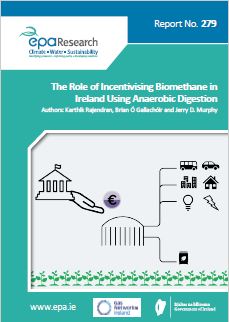Authors: Karthik Rajendran, Brian Ó Gallachóir and Jerry D. Murphy
Summary: Ireland’s renewable energy targets for 2020 include 16% renewable energy; this can be broken down to 40% renewable electricity, 12% renewable heat and 10% renewable transport. Owing to the commercialisation of wind energy, the progression of carbon-free electricity generation is under way; however, this is not the case for heat and transport.

The 2020 renewable energy target for Ireland is 16%; this can be broken down into 40% renewable electricity, 12% renewable heat and 10% renewable transport. Typically, electricity comprises about 20% of final energy demand. The path to decarbonise electricity is mature because of the commercialisation of wind energy, but this is not the case for transport and thermal energy. Ireland has mandatory greenhouse gas (GHG) emissions reduction targets of 20% by 2020 and 30% by 2030, both relative to 2005 levels; the 2020 target will not be met and we are not on track to meet the 2030 target. These targets apply to GHG emissions outside the European Union Emissions Trading System (EU-ETS). Renewable electricity does not contribute to our mandatory emissions reduction target because electricity generation is included in the EU-ETS. Transport, thermal energy and agriculture are the largest contributors to Ireland’s non-ETS GHG emissions. Biomethane is recommended for use in thermal and transport energy. An outcome of this project is a detailed techno–economic–environmental analysis of biomethane; for example, food waste biomethane was shown to require a minimum incentive of €0.13/L diesel equivalent in converting waste to sustainable green fuel.
Ireland plans to stop the purchase of diesel buses by Bus Éireann after 2019 and petrol and diesel cars by 2030. Electric vehicles (EVs) offer a solution to cars but electrification is not seen as viable for haulage and coaches. The recast Renewable Energy Directive has capped the production of first- generation biofuels (from food crops) at 3.8% of energy in transport by 2030 and set a target of 6.8% for low-carbon-transport fuels (excluding biofuels sourced from food crops). Biomethane can contribute to this 6.8% target and has significant potential to reduce the carbon intensity of haulage and bus fleets through the use of existing natural gas vehicles (NGVs); this technology is proven and commercially available. However, there are no incentives for the use of biomethane as a fuel for NGVs. There are very significant levels of incentives in place for EVs (more than €10,000 per vehicle in capital incentives and reduced Vehicle Registration Tax). This report highlights that this incentive is in the range of €666–1940/ tCO2 avoided, compared with renewable energy supports across Europe that typically have incentive levels of less than €260/ tCO2 avoided.
According to the latest Intergovernmental Panel on Climate Change (IPCC) analysis, GHG emissions will need to reduce to zero by 2050 to comply with the Paris Agreement. Financial prudence is required at governmental level and, as such, incentives should be targeted at ensuring an optimum replacement of CO2 per euro of incentive. A major finding of this report was the extremely high level of incentive per unit of CO2 avoided for EV systems in Ireland. This may be justified by the need to initiate a significant change in infrastructure associated with charging points and the use of more expensive vehicles. These subsidies may be reduced in the future when the industry is mature. Similar solutions are required for biomethane, which can contribute to the 6.8% low-carbon-transport fuel target, especially in haulage and bus fleets. This report recommends a biomethane obligation scheme (20% of natural gas to be renewable by 2030), reducing the cost to government of support for the industry. However, for transport applications, this should be coupled with Vehicle Relief Tax relief and provision of capital grants for NGVs and NGV service stations.
https://www.epa.ie/media/epa-2020/publications/research/Research_279_Thumbnail[1].jpg